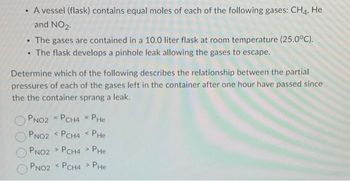
Chemistry
10th Edition
ISBN: 9781305957404
Author: Steven S. Zumdahl, Susan A. Zumdahl, Donald J. DeCoste
Publisher: Cengage Learning
expand_more
expand_more
format_list_bulleted
Concept explainers
Question

Transcribed Image Text:• A vessel (flask) contains equal moles of each of the following gases: CH4, He
and NO2.
The gases are contained in a 10.0 liter flask at room temperature (25.0°C).
.
• The flask develops a pinhole leak allowing the gases to escape.
.
Determine which of the following describes the relationship between the partial
pressures of each of the gases left in the container after one hour have passed since
the the container sprang a leak.
PNO2 = PCH4 = PHe
PNO2 < PCH4 < PHe
PNO2 PCH4> PHe
PNO2 < PCH4>
PHE
>
Expert Solution
This question has been solved!
Explore an expertly crafted, step-by-step solution for a thorough understanding of key concepts.
Step by stepSolved in 3 steps with 17 images

Knowledge Booster
Learn more about
Need a deep-dive on the concept behind this application? Look no further. Learn more about this topic, chemistry and related others by exploring similar questions and additional content below.Similar questions
- The typical human lung has a volume when full of approximately 5.0 L. The partial pressure of oxygen in the atmosphere is 160 mm Hg (1 atm = 760 atm). How many moles of oxygen are in the typical human lung when full? (You can assume the air in the lungs is at a normal human body temperature of 37oC.)arrow_forwardA 1.25 g sample of an unknown gas at 47 ∘C and 1.00 atm is stored in a 2.55 L flask. What is the density of the gas? density: g/L What is the molar mass of the gas? molar mass: g/molarrow_forwardA mixture of nitrogen and xenon gases, in a 5.99 L flask at 50 °C, contains 2.90 grams of nitrogen and 43.1 grams of xenon. The partial pressure of xenon in the flask is atm and the total pressure in the flask is atm.arrow_forward
- An unknown gas at 79.1 ∘C and 1.10 atm has a molar mass of 16.04 g/mol. Assuming ideal behavior, what is the density of the gas? density: g/Larrow_forwardA 91.4 L glass bulb has a total pressure of 760 torr at 0 C and contains three different gases, nitrogen, helium and argon. If the partial pressure of nitrogen is 150 torr and the partial pressure of argon is 330 torr, what is the number of moles of helium in the tank?arrow_forward
arrow_back_ios
arrow_forward_ios
Recommended textbooks for you
 ChemistryChemistryISBN:9781305957404Author:Steven S. Zumdahl, Susan A. Zumdahl, Donald J. DeCostePublisher:Cengage Learning
ChemistryChemistryISBN:9781305957404Author:Steven S. Zumdahl, Susan A. Zumdahl, Donald J. DeCostePublisher:Cengage Learning ChemistryChemistryISBN:9781259911156Author:Raymond Chang Dr., Jason Overby ProfessorPublisher:McGraw-Hill Education
ChemistryChemistryISBN:9781259911156Author:Raymond Chang Dr., Jason Overby ProfessorPublisher:McGraw-Hill Education Principles of Instrumental AnalysisChemistryISBN:9781305577213Author:Douglas A. Skoog, F. James Holler, Stanley R. CrouchPublisher:Cengage Learning
Principles of Instrumental AnalysisChemistryISBN:9781305577213Author:Douglas A. Skoog, F. James Holler, Stanley R. CrouchPublisher:Cengage Learning Organic ChemistryChemistryISBN:9780078021558Author:Janice Gorzynski Smith Dr.Publisher:McGraw-Hill Education
Organic ChemistryChemistryISBN:9780078021558Author:Janice Gorzynski Smith Dr.Publisher:McGraw-Hill Education Chemistry: Principles and ReactionsChemistryISBN:9781305079373Author:William L. Masterton, Cecile N. HurleyPublisher:Cengage Learning
Chemistry: Principles and ReactionsChemistryISBN:9781305079373Author:William L. Masterton, Cecile N. HurleyPublisher:Cengage Learning Elementary Principles of Chemical Processes, Bind...ChemistryISBN:9781118431221Author:Richard M. Felder, Ronald W. Rousseau, Lisa G. BullardPublisher:WILEY
Elementary Principles of Chemical Processes, Bind...ChemistryISBN:9781118431221Author:Richard M. Felder, Ronald W. Rousseau, Lisa G. BullardPublisher:WILEY

Chemistry
Chemistry
ISBN:9781305957404
Author:Steven S. Zumdahl, Susan A. Zumdahl, Donald J. DeCoste
Publisher:Cengage Learning

Chemistry
Chemistry
ISBN:9781259911156
Author:Raymond Chang Dr., Jason Overby Professor
Publisher:McGraw-Hill Education

Principles of Instrumental Analysis
Chemistry
ISBN:9781305577213
Author:Douglas A. Skoog, F. James Holler, Stanley R. Crouch
Publisher:Cengage Learning

Organic Chemistry
Chemistry
ISBN:9780078021558
Author:Janice Gorzynski Smith Dr.
Publisher:McGraw-Hill Education

Chemistry: Principles and Reactions
Chemistry
ISBN:9781305079373
Author:William L. Masterton, Cecile N. Hurley
Publisher:Cengage Learning

Elementary Principles of Chemical Processes, Bind...
Chemistry
ISBN:9781118431221
Author:Richard M. Felder, Ronald W. Rousseau, Lisa G. Bullard
Publisher:WILEY